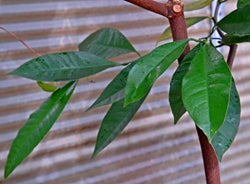Malayan atalantia
CRC 4190
PI 600634
Source
Received as seed from Malaysia, 1991.
Parentage/origins
Parents unknown.
Origin
Bukit Sedanan Forest Reserve, Jasin District.
Rootstocks of accession
Carrizo citrange, C-35 citrange
Season of ripeness at Riverside
Unknown at this time.
Notes and observations
"...Derived from wild plants collected on August 19, 1990 at Bukit Sedanan Forest Reserve, Jasin District, Melaka, West Malaysia." (letter from D.T. Jones to T.E. Williams dated August 24, 1990.
Description from The Citrus Industry Vol. 1 (1967):
"A sprawling thornless shrub, ultimate branchlets slender, 1.5-2.5 mm diam., soon terete, glabrous; leaves large, lanceolate or long-elliptical, tapering toward both ends, but often acute or shortly subacuminate at apex and sometimes broadly cuneate or rounded at base, 9-21 cm long (including petiole), 2-4 cm wide, glabrous, subcoriaceous, with abundant veins visible on both surfaces, primary veins very abundant, 10-12 stronger ones and as many fainter ones arising at an angle of 70°-80° with the midrib; petioles short, 6-10 mm long, 1.3-1.8 mm wide, with a very narrow, almost closed canal, 0.3-0.7 mm wide, on the upper side, glabrous, articulated with the leaf blade; flowers not seen; inflorescences (bearing fruits) axillary, 1-6 cm long, peduncle often simple, bearing pedicels 5-6 mm long, 0.6-1 mm wide; calyx lobes 4, persistent, glabrous, rounded, margins thin, sparingly ciliate; fruits subglobose, 1.5-2 cm diam., young fruits 2-locular, with abundant sessile, conical pulp-vesicles, older fruits often nearly full of oblong seeds, 10-12 X 4-6 mm; oil glands in peel rather sparse and often large, 0.3-1 mm diam.
This seems to be a very well-defined species, easily recognized by its being spineless and having unusually long leaves with short petioles, less than one-tenth as long as the blade, which have a nearly closed canal on the upper side. It is closely related to A. simplicifolia, which has smaller acuminate or caudate leaves. Two varieties of A. roxburghiana are described below.
The nomenclature of this species and of A. simplicifolia is badly confused, so badly confused that it cannot be settled finally without further study of the type material of both A. roxburghiana and A. simplicifolia. It is possible that the name here used can be considered as legal since it was based, in part, on fruiting material that doubtless belongs to the species as here described. Unfortunately, the original description was also based on a misleading illustration of Amyris simplicifolia Roxb. which does not agree with the original description of Amyris simplicifolia or with the type specimen of it preserved in the British Museum."
Availability
Not commercially available in California.
USDA Germplasm Resources Information Network page for Atalantia roxburghiana

